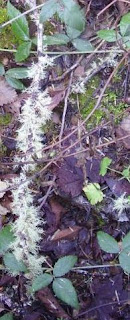Native Plant Salvage I: Usnea--Old Man's Beard
Dr. Terry let us know of a native plant salvage going on in Redmond a couple of Saturdays ago, and we showed up to find a very muddy site!

The site was up a hill of boot-sucking mud, where we found some hard-core salvage work to be done. The slope was a challenge to get up, laden with tools and bags, and the site was surrounded by fallen logs, which required some climbing to get over.



Terry observed that there were few medicinal plants, but a lot of good ground cover for replanting at other sites.
One of the plants(?--I don't know; I'm coming at this from a mammalian background, and am rather a botany virgin, but learning) which does have medicinal usage is Old Man's Beard, one of the Usnea species. Usnea is a lichen, which is the part I have not fully grokked yet--it is one of those combination organisms, in this case a fungus and a photosynthesizer, in this case, algae.

In this picture, you can see the Usnea growing on a fallen branch. My close-ups, however, sucked, so you won't get to see Terry showing me how you can tell real Usnea: when you pull it apart, the innermost layer resists and stretches like a tiny rubber band. She explained that Native Americans had used it to fight infection, and a PubMed search later showed that Usnea spp. are used against candida in Thailand [1], and other fungi and protozoans in the Andes [2].
It is known all over the Northwest--according to James Crippen, now at the University of Hawai'i, the Tlingit word for one species is tl’éx, meaning brown tree lichen, possibly speckled horsehair (Bryoria fuscescens) or methuselah’s beard (Usnea longissima).
Daniel E. Moerman, in Native American Ethnobotany, lists the following documented usages in the Northwest/Canadian Southwest:

Michael Moore describes how to make an Usnea tincture; I have not tried this out myself yet, but it seems consistent with other tinctures I've seen described.

All in all, a good day's hard work, and a lot of learning, even if the medicinal plants are rather sparse at this site.
An independent organism comprised of two symbiotic individuals is a fascinating concept, and I am looking forward to learning more about plants, medicinal plants, and lichens. In my familiar mammalian world, symbiosis is usually a little less structural and more physiological.
[1] Rukayadi Y, Shim JS, Hwang JK. Screening of Thai medicinal plants for anticandidal activity. Mycoses. 2008 Jul;51(4):308-12.
[2] Schmeda-Hirschmann G, Tapia A, Lima B, Pertino M, Sortino M, Zacchino S, Arias AR, Feresin GE. A new antifungal and antiprotozoal depside from the Andean lichen Protousnea poeppigii. Phytother Res. 2008 Mar;22(3):349-55.
Labels: lichens, plant salvage, plants

0 Comments:
Post a Comment
<< Home